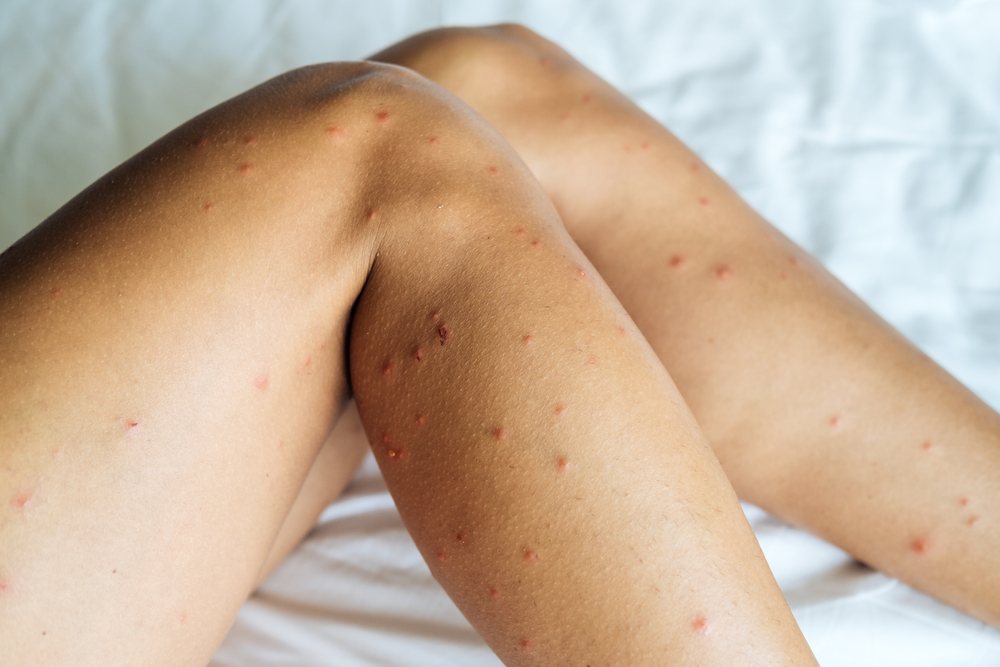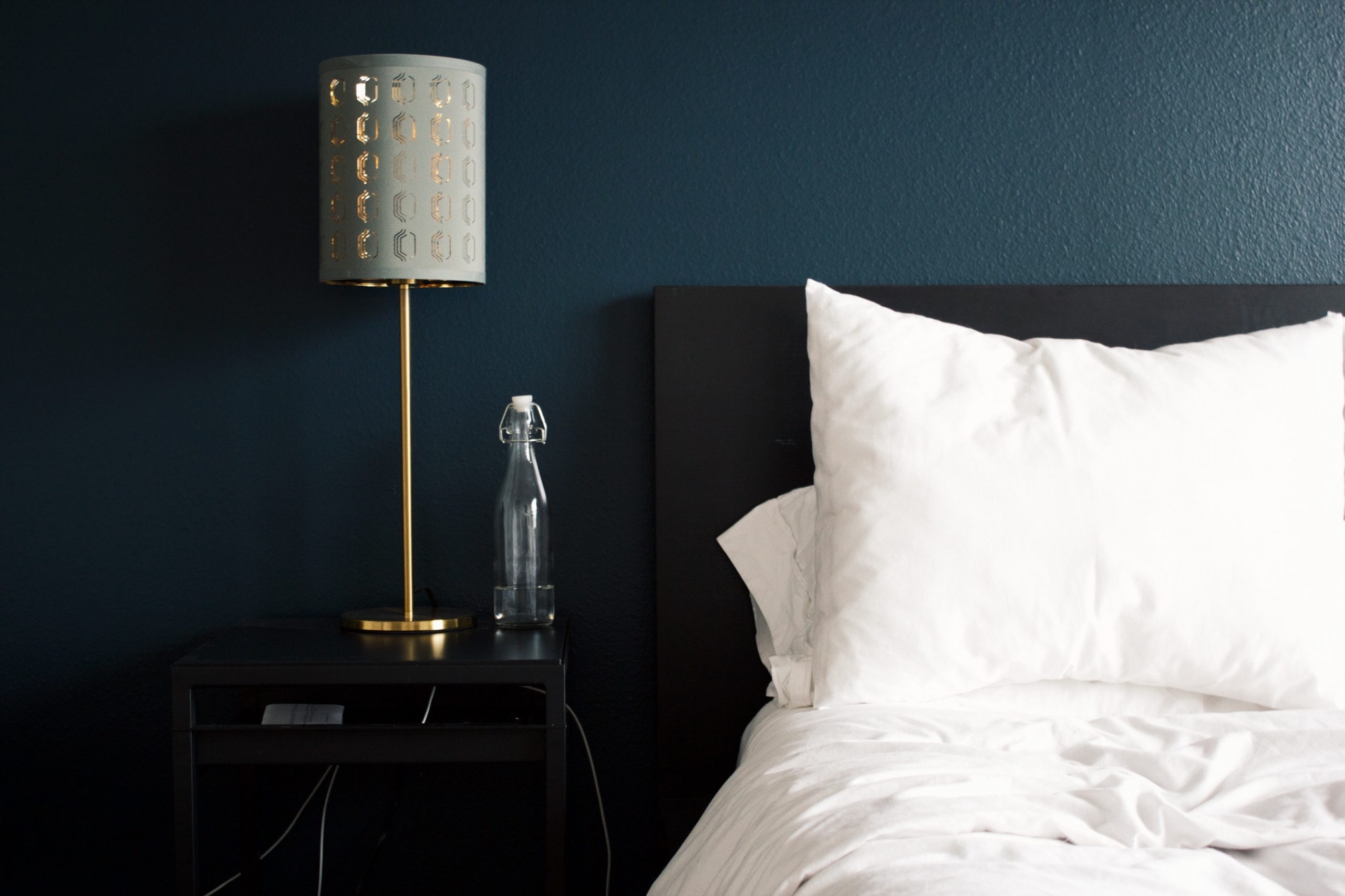Notice any suspicious stains on your sheets recently?
This could be the first sign of a bed bug infestation.
Bed bugs typically gather in and around bedding.
(It’s in their name, after all).
They typically reside in niche corners of the bed such as:
- Behind the headboard.
- Under the sheets.
- Within the folds of the mattress.
- Sides of the bed frame.
Bed bugs can leave behind traces of their existence that often come in the form of red or brown stains on your sheets.
If you’re unlucky enough to spot one or more of the below signs, it’s time to consider your options for bed bug removal.
Page Contents:
Early Signs of Bed Bugs
If you suspect bed bugs in your home, there are several indicators of an infestation that you should be aware of.
Here are 8 early signs of an active bed bug infestation:
1. Live Bed Bugs
The most obvious sign of a bed bug infestation is the bed bugs themselves. Bed bugs are small, reddish-brown insects that primarily come out at night.
Bed bugs will form colonies in secluded, remote areas of your home. They commonly build their nests in and around beds, but bed bugs will settle anywhere that offers a decent hiding place.
2. Bed Bug Eggs
Where there are adult bed bugs, there are bed bug eggs.
In fact, a female bed bug can lay an average of 200-250 eggs in its lifetime.
The eggs will hatch relatively quickly.
(Roughly 7 days after being laid).

Bed bug eggs are very tiny, only 1 mm in length. They have a pearly-white color to them and can be found stuck to hard surfaces.
3. Bed Bug Shells
Bed bugs leave behind 2 types of shells.
The 1st are eggshells, left behind once the larvae hatch from their eggs. A bed bug eggshell is nearly transparent in color, making it difficult to tell apart from an unhatched egg.
The 2nd are exoskeletons which are shed by bed bugs as they mature. These shed skins are translucent and yellowish-brown in color.
Because they have the same shape as a bed bug, it can be hard to tell at a glance if you’re looking at a shell or a live bed bug.
4. Bite Marks
If you don’t immediately notice bed bugs in your home, then you’ll start noticing them once you see bed bug bites on your skin.
Bed bugs are nocturnal feeders and will come out to feed on human blood while you’re asleep. Bed bug bites are small, red welts that may appear in patterns along the upper torso.

Common areas that people are bitten include:
- Back
- Neck
- Arms
- Shoulders
- Face
The above areas are most common because they’re typically more accessible areas of exposed skin.
If you do notice bed bug bites on your body, do not scratch them. Although bug bites tend to itch, repeated scratching will keep the wound open and potentially lead to infection.
Bed bug bites typically heal after 1 to 2 weeks.
5. Musty Odor
Notice a distinct, musty odor in your room?
Can’t find any apparent cause for it?
Then it’s likely caused by bed bugs.
The scent is actually an alarm pheromone produced by bed bugs when they feel threatened.
Normally, these pheromones only produce a light smell–nearly undetectable to the human nose. A musty odor only becomes noticeable when large numbers of bed bugs make these hormones at the same time.
How to Remove Stains on Sheets
If you notice blood or fecal stains on your sheets, you can easily wash them in your laundry. Before you do, spray your sheets with special enzyme-based laundry cleaners, and allow them to sit for 30 minutes.
Once the cleaner has dried, you can wash and dry your sheets as normal. It’s recommended to turn your dryer’s heat to the highest setting possible, as extreme heat can kill any bed bugs attached to the bedding.
What Do Bed Bug Stains Look Like?
Bed bug stains can vary in appearance, but they typically consist of two main types of stains:
Fecal stains and blood stains.
These stains are often left behind as a result of bed bug feeding and their waste products.
Here’s what each type of stain looks like:
1. Fecal Stains:
Bed bug fecal stains are usually small, dark, and brownish in color. They may appear as clusters or individual spots, often in areas where bed bugs hide or rest.
These stains are the result of bed bugs digesting blood and excreting waste.
Bed bug poop can be found on any of the following:
- Mattresses and box springs, especially in seams, folds, and crevices.
- Bedding, such as sheets, pillowcases, and duvet covers.
- Upholstered furniture, like couches and chairs.
- Curtains and drapes.
- Baseboards and wall junctions near the bed.
2. Blood Stains:
Blood stains are the result of bed bugs being crushed or accidentally punctured during feeding.
When you move in your sleep or rollover, you might inadvertently crush a feeding bed bug.
These stains are reddish or rust-colored and may be more spread out than fecal stains.
Blood stains can be found on:
- Bed sheets, pillowcases, and other bedding.
- Mattress covers or encasements.
- Pajamas or clothing that you were wearing while sleeping.
- Upholstered furniture.
So Do Blood Stains on Sheets Definitely Mean I Have Bed Bugs?
Not necessarily. It’s important to note that while these stains can be indicative of a bed bug infestation, they are not a definitive sign on their own.
How to Clean Bed Bug Stains
Cleaning bed bug stains can be challenging, but here are some steps you can take to effectively clean and remove bed bug stains from various surfaces:
Materials You’ll Need:
- Gloves
- Mask (for protection against potential allergens)
- A vacuum cleaner with an upholstery attachment
- Stiff brush
- Enzyme-based cleaner or laundry pre-treatment
- Cold water
- Clean cloths or paper towels
- Plastic bags
Steps for Cleaning Bed Bug Stains:
1. Follow Safety Precautions: Wear gloves and a mask to protect yourself from potential allergens or irritants.
2. Vacuum with the Right Attachment: Begin by using a vacuum cleaner with an upholstery attachment to gently vacuum the stained area. This will help remove any loose debris, dirt, or bed bug excrement.
3. Brush Appropriately: Use a stiff brush to gently scrub the stained area. Be careful not to damage the fabric or surface. This can help loosen and remove dried bed bug stains.
4. Use an Enzyme-Based Cleaner: Apply an enzyme-based cleaner or laundry pre-treatment to the stained area. Enzyme cleaners are effective at breaking down organic materials, including bed bug excrement and stains.
5. Blotting Not Rubbing: Use a clean cloth or paper towel to blot the stained area. Avoid rubbing, as this can spread the stain further.
6. Cold Water Rinse: Rinse the area with cold water to remove the enzyme cleaner and any remaining stain residue. Blot the area again to remove excess moisture.
7. Repeat if Necessary: If the stain persists, you may need to repeat the enzyme cleaner application and blotting process until the stain is no longer visible.
8. Drying: Allow the cleaned area to air dry. Avoid using high heat or direct sunlight, as this can set the stain.
9. Dispose of Materials: Dispose of the gloves, mask, and any cleaning materials, such as cloths or paper towels, in a sealed plastic bag to prevent the potential spread of allergens.
Before attempting to clean bed bug stains, make sure you have effectively treated and eliminated the bed bug infestation itself. Cleaning alone will not solve the underlying problem.
Other general suggestions to keep in mind:
1. Always follow the instructions on the enzyme cleaner or pre-treatment product you’re using.
2. Test the cleaner on a small, inconspicuous area first to ensure it doesn’t cause any damage or discoloration to the fabric or surface.
3. If the stained item is machine washable, follow the manufacturer’s instructions for washing. Use the hottest water temperature that is safe for the fabric.
4. It’s important to note that while cleaning bed bug stains can help improve the appearance of the affected area, it won’t eliminate the underlying bed bug infestation. If you’re dealing with bed bugs, it’s crucial to address the infestation through thorough professional pest control assistance.
How Do I Detect Bed Bugs Early?
There’s no sure way of detecting bed bugs in your home early on. By the time you notice them, an infestation has already gotten large enough to be a problem.
Many people first become aware of bed bugs once they notice bite marks on their bodies. Bed bug bites are ½ an inch in size and look like red welts. Bed bug saliva contains antihistamines, which prevent the immune system from responding immediately.
Once these antihistamines wear off, the area around the bite will start to itch.
Can You Crush a Bed Bug?
Crushing bed bugs is so easy, you could do it in your sleep!
Quite literally, actually.
If you toss and turn in your sleep, there’s a good chance you’ll end up crushing bed bugs.
Bed bugs are very slow insects. They can’t go any faster than a crawl, and their bodies aren’t built for jumping or flight.
That makes returning to their nest a dangerous trip because there’s no way for them to escape quickly when in danger.
You should not intentionally crush bed bugs as a means of dealing with an infestation. There are more effective methods for dealing with bed bugs, such as:
- Heat treatments
- Pesticides
- Diatomaceous Earth.
It’s essential to address the entire infestation rather than just individual bugs.
If you suspect you have a bed bug infestation, it’s best to consult with a pest control professional near you to discuss the most effective treatment options.




